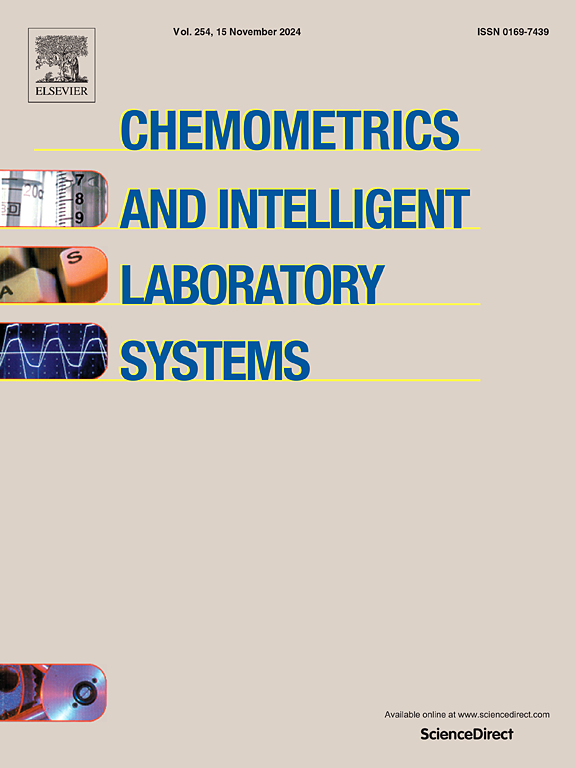Chemometric modelling of anticancer drugs using CatBoost regression and graphical derivatives
IF 3.8
2区 化学
Q2 AUTOMATION & CONTROL SYSTEMS
Chemometrics and Intelligent Laboratory Systems
Pub Date : 2025-10-17
DOI:10.1016/j.chemolab.2025.105551
引用次数: 0
Abstract
In this work, a chemometric methodology based on graph topology descriptors and CatBoost regression is proposed for predicting the physicochemical properties of anticancer drugs. Molecular structures were encoded as graphs, and degree-based topological descriptors were derived to capture their complexity. These descriptors were used in the construction of regression models predicting boiling point, molar refractivity, and polarizability. The first statistical analysis with linear and cubic regression demonstrated that models of order higher than unity were able to take into account the non-linear dependence of descriptors vs. molecular properties. CatBoost regression model was used for improved predictability and better interpretability. This model exhibits a coefficient of determination of 0.997 for the prediction of boiling point and superior performance across all the other two properties, with average absolute errors lower than 2%. Of importance, we identified several graph descriptors as important predictors, which confirmed their chemometric relevance. The method may contribute with useful information as a complementary method to current machine learning-based models used for prediction of drug properties in chemoinformatics or pharmaceutical drug development, it integrates chemical graph theory with intelligent reasoning and modeling for a more fault tolerant and generalized 1 solution to drug property prediction.
使用CatBoost回归和图形衍生物的抗癌药物化学计量学建模
在这项工作中,提出了一种基于图拓扑描述符和CatBoost回归的化学计量学方法来预测抗癌药物的物理化学性质。将分子结构编码为图形,并推导出基于度的拓扑描述符来捕获其复杂性。这些描述符被用于构建预测沸点、摩尔折射率和极化率的回归模型。线性和三次回归的第一次统计分析表明,高于单位阶的模型能够考虑到描述符与分子性质的非线性依赖。CatBoost回归模型用于提高可预测性和更好的可解释性。该模型在沸点预测上的决定系数(R2)为0.997,在其他两项性能上均表现优异,平均绝对误差小于2%。重要的是,我们确定了几个图形描述符作为重要的预测因子,这证实了它们的化学计量学相关性。该方法可以为化学信息学或药物开发中用于预测药物性质的当前基于机器学习的模型提供有用的信息,它将化学图论与智能推理和建模相结合,为药物性质预测提供了更容错和更广义的解决方案。
本文章由计算机程序翻译,如有差异,请以英文原文为准。
求助全文
约1分钟内获得全文
求助全文
来源期刊
CiteScore
7.50
自引率
7.70%
发文量
169
审稿时长
3.4 months
期刊介绍:
Chemometrics and Intelligent Laboratory Systems publishes original research papers, short communications, reviews, tutorials and Original Software Publications reporting on development of novel statistical, mathematical, or computer techniques in Chemistry and related disciplines.
Chemometrics is the chemical discipline that uses mathematical and statistical methods to design or select optimal procedures and experiments, and to provide maximum chemical information by analysing chemical data.
The journal deals with the following topics:
1) Development of new statistical, mathematical and chemometrical methods for Chemistry and related fields (Environmental Chemistry, Biochemistry, Toxicology, System Biology, -Omics, etc.)
2) Novel applications of chemometrics to all branches of Chemistry and related fields (typical domains of interest are: process data analysis, experimental design, data mining, signal processing, supervised modelling, decision making, robust statistics, mixture analysis, multivariate calibration etc.) Routine applications of established chemometrical techniques will not be considered.
3) Development of new software that provides novel tools or truly advances the use of chemometrical methods.
4) Well characterized data sets to test performance for the new methods and software.
The journal complies with International Committee of Medical Journal Editors'' Uniform requirements for manuscripts.

 求助内容:
求助内容: 应助结果提醒方式:
应助结果提醒方式:


